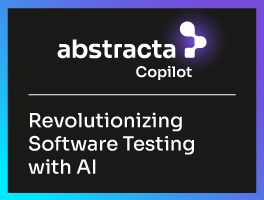Explore how AI and ML are transforming automated testing. Learn about tools, benefits, challenges, solutions, metrics, and future trends hand in hand with Abstracta’s AI experts.


Automated testing, powered by Artificial Intelligence (AI) and machine learning (ML), is transforming the landscape of software quality assurance. In this article, we delve into the integration of these advanced technologies in automated testing, highlighting their benefits, how to measure their success, challenges, and practical solutions.
Unlock the full potential of your software with our AI-driven solutions! Check our Clutch reviews and Contact us!
The Basics of Automated Testing
As we’ve already seen in our comprehensive automated functional testing guide, automated testing is the process of using software tools to execute pre-scripted tests on a software application before it is released into production.
Unlike manual testing, which requires full human intervention, automated testing runs tests automatically, saving time and reducing human error.
Test automation is the foundation upon which AI and ML can build to further enhance software quality. Let’s explore how to integrate AI and ML to maximize your software quality!
Integrating AI and ML in Automated Testing


AI and ML bring a new level of sophistication to automated testing. These technologies enable the testing process to become more intelligent and adaptive.
How AI and ML Enhance Testing:
- Predictive Analysis: AI can predict potential problem areas in the software, allowing testers to focus on high-risk areas.
- Self-Healing Scripts: ML algorithms can adjust test scripts automatically when there are changes in the application, reducing test maintenance efforts.
- Test Optimization: AI can analyze test results to identify redundant tests and optimize the test suite for better coverage and efficiency.
By leveraging AI and ML, automated testing becomes more robust and capable of handling complex software systems.
As we delve deeper, let’s discuss the automation testing tools, powered by AI, that are capable of enhancing any test automation project.
Recommended Tools for AI and ML in Testing
There exist several tools available that incorporate AI and ML to enhance test automation. Here are some of the most recommended ones:
Top AI and ML Testing Tools
- Abstracta Copilot: Boosts productivity by 30% while cutting costs. How? Quickly generates test cases from user stories and manages instant system documentation. It seamlessly integrates with existing development workflows and transforms how testing teams interact with technology.
- mabl: Simplifies and accelerates the software testing lifecycle. It combines advanced machine learning technologies with a user-friendly interface to create, execute, and maintain automated tests efficiently.
- Testim by Tricentis: Streamline the creation, execution, and maintenance of tests for web and mobile applications. It creates automated tests through a low-code interface, making it accessible to both technical and non-technical users.
- Tricentis Tosca: Enables users to design and execute automated tests without extensive coding, making it accessible to both technical and non-technical team members.
- Perfecto: Accelerates the delivery of high-quality web and mobile applications. It provides a cloud-based environment for executing automated tests across a wide range of real devices and browsers.
- TestRigor: Empowers users to create automated tests using plain English commands, minimizing the need for complex scripting. It interprets these natural language instructions to generate and execute reliable tests across web, mobile, and desktop applications.
- Autoplaywright: Integrates AI capabilities into Playwright. By leveraging OpenAI’s technology, it translates natural language prompts into executable test scripts, simplifying the test creation process and making it more accessible.
These tools are designed to make the testing process more efficient and reliable, aiming for high-quality software delivery. You can explore our in-depth reviews of these AI-powered testing tools in this article.
Moving forward, let’s address the challenges faced when implementing these technologies.
Revolutionize Your Testing with Abstracta Copilot! Boost productivity by 30% with our new AI-powered assistant for efficient testing.
Overcoming Challenges in AI and ML Testing


Adopting AI and ML in automated testing brings significant advantages, but it also comes with a set of challenges that require careful consideration and strategic solutions. Below, we delve deeper into the most common obstacles and actionable ways to tackle them effectively.
Common Challenges and Solutions
1. Data Quality
The success of any ML model heavily depends on the quality of the training data it is exposed to. Poor-quality data—whether incomplete, inconsistent, or biased—can lead to unreliable models and inaccurate testing results.
Solution: Focus on building a robust data preprocessing pipeline. This includes data cleaning, normalization, and augmentation to enhance data quality. Leveraging automated tools for data validation can also streamline processes and improve consistency.
2. Model Training
Training ML models are computationally intensive and can become a bottleneck, especially for teams with limited infrastructure. The time and resources required to fine-tune models can also impact testing timelines.
Solution: Utilize cloud-based platforms like AWS, Azure, or Google Cloud to access scalable computing resources. These platforms also offer specialized ML services to optimize model training and deployment, reducing the need for on-premise hardware.
3. Integration Complexity
Integrating AI and ML tools into existing testing frameworks often requires extensive customization, which can slow down the adoption process. Compatibility issues between legacy systems and modern tools further complicate this challenge.
Solution: Select tools designed for seamless integration with your current tech stack. Open-source solutions and tools offering APIs or plugins can simplify this process. Additionally, adopting modular testing frameworks can provide more flexibility and compatibility.
4. Interpretability and Trust
One of the unique challenges of AI-driven testing is the “black-box” nature of ML models. Teams may find it difficult to fully understand or rely on the model’s predictions.
Solution: Leverage explainable AI (XAI) techniques that offer insights into how models make decisions. This fosters trust among stakeholders and aligns results with testing objectives.
5. Skill Gaps in Teams
Deploying and managing AI/ML tools often requires specialized knowledge that may not be readily available within the team.
Solution: Promote skill development through training programs or collaborate with experienced vendors who can guide implementation.
By proactively addressing these challenges, organizations can unlock the full potential of AI and ML in their testing processes, driving higher efficiency, accuracy, and scalability.
As we’ve explored how to navigate these challenges, it’s clear that data lies at the heart of successful AI and ML testing. Let’s now dive into the critical role of data analysis in enhancing the effectiveness of AI-driven testing solutions.
The Role of Data Analysis in Testing


Data analysis is fundamental in AI and ML testing. It enhances understanding of test results, supports better testing strategies, and aligns testing efforts with both immediate and long-term quality objectives.
Importance of Data Observability and Analysis
1. Insight Generation
Testing generates large volumes of complex data. Through structured analysis, teams can identify patterns and trends that might otherwise go unnoticed. For example:
- Detecting recurring defects in specific areas of the application.
- Pinpointing performance issues under certain conditions.
These insights allow teams to address critical areas more effectively, optimizing testing efforts and saving valuable time.
2. Continuous Improvement
AI and ML models require ongoing refinement as they interact with evolving data sets. Analyzing test data highlights areas for optimization, enabling iterative improvements to both models and testing processes.
Example: Trends in false positives or negatives can guide adjustments to the testing framework, increasing the reliability of results over time.
3. Informed Decision-Making
Rapid and data-backed decisions are essential in fast-moving development cycles. By analyzing test results, teams can:
- Prioritize high-risk areas.
- Select test cases with the greatest impact on quality.
- Determine when a model or application is ready for production.
This approach minimizes guesswork and helps teams move forward with greater clarity and confidence.
4. Real-Time Monitoring and Adaptation
Advanced tools allow for real-time observability and analysis, enabling teams to detect anomalies or unexpected behaviors during testing. This proactive strategy helps address issues early, reducing the likelihood of costly failures in production.
5. Collaboration Across Teams
Clear, data-driven insights foster collaboration between developers, testers, and business stakeholders. Dashboards, visualizations, and automated reports make complex testing results visible and accessible, promoting alignment and shared understanding across the organization.
Why Data Analysis Matters
Effective data analysis transforms testing into a dynamic, insight-driven process. It allows AI and ML models to adapt and improve over time, enhancing the reliability and relevance of testing outcomes while driving better software quality overall.
Now that we’ve explored the significance of data analysis, let’s examine how to measure the impact of AI and ML on automated testing and evaluate its contributions to your team’s goals.
Accelerate your cloud journey with our joint services with Datadog! We joined forces to leverage real-time infrastructure monitoring services and security analysis solutions for modern applications.
How to Measure Success in AI and ML Testing?


Evaluating the success of AI and ML in automated testing goes beyond confirming their benefits—it’s about understanding their impact and aligning them with your quality goals. But how do you measure success effectively?
Here are some key metrics to track:
Key Metrics for Success
- Test Coverage
Assess the percentage of your application that automated testing covers. A higher coverage reduces blind spots, but focus on critical paths and high-risk areas to maximize the value of your tests. - Defect Detection Rate
Track the number of defects identified by automated testing. This metric reflects how well your test suite identifies potential issues before they impact users. - Test Execution Time
Measure the time it takes to execute your automated tests. Faster execution speeds up feedback loops, enabling quicker iterations and reducing delays in development cycles.
As we wrap up this section, let’s look at the future trends in AI and ML testing.
The Future of AI and ML in Test Automation


The future of AI and ML in automated testing is promising, with several trends emerging.
Emerging Trends
- AI-Driven Test Creation: AI will increasingly be used to create test cases automatically, leveraging application data, user behavior, and historical test results. This empowers human testers to concentrate on areas where their unique strengths—such as critical thinking, creativity, curiosity, and nuanced judgment—have the greatest impact.
- Enhanced Predictive Analytics: More advanced predictive analytics will help identify potential issues before they occur. Future tools may integrate real-time telemetry and broader datasets to provide even more accurate insights into areas of risk.
- Deeper integration with DevOps: AI and ML will become integral parts of the DevOps pipeline, promoting continuous testing and delivery. These technologies will adapt testing efforts dynamically based on changes in code and deployment environments.
- Self-Healing Automation: Testing scripts powered by machine learning will automatically adapt to changes in application architecture, reducing the need for manual updates and minimizing downtime in automated testing workflows.
- AI-Augmented Exploratory Testing
While automation dominates repetitive testing, AI is set to augment exploratory testing by guiding testers to high-risk areas, suggesting paths that human testers might overlook. This blend of human intuition and AI assistance will enrich the testing process, focusing efforts where they matter most. - Context-Aware Automation
The future of automation will involve AI that understands the broader context of applications, such as user intent and environmental variables. This enables more realistic simulations and better validation of user-centric features, ensuring a smoother user experience.
These trends indicate that AI and ML will continue to play a significant role in the evolution of automated testing.
FAQs about Automated Testing AI and ML


Is Automated Testing AI?
No, automated testing and AI are not the same. Automated testing uses scripts or tools to perform repetitive tasks in the testing process, often based on predefined instructions. AI in testing, on the other hand, introduces intelligence by learning from data, identifying patterns, and adapting testing approaches dynamically. While automation focuses on efficiency, AI enhances testing by adding predictive and analytical capabilities.
What Is AI ML Automation?
AI ML automation refers to the integration of Artificial Intelligence (AI) and Machine Learning (ML) into automation processes. In testing, this means leveraging AI and ML to optimize tasks like test case generation, defect prediction, and anomaly detection. Unlike traditional automation, which follows fixed scripts, AI ML automation evolves based on data, making it more adaptable and insightful for complex testing scenarios.
How to Use AI and ML in Automation Testing?
AI and ML can transform automation testing in several ways:
- Test Case Optimization: Use AI to analyze past test results and prioritize the most critical test cases.
- Defect Prediction: ML models can predict areas of the application likely to fail based on historical data.
- Visual Testing: AI-driven tools can detect UI inconsistencies that are difficult to catch with traditional methods.
- Self-Healing Scripts: ML-powered tools can adapt scripts automatically when application elements change.
- Performance Analysis: AI can monitor performance metrics, identifying bottlenecks and anomalies in real time.
Start by exploring tools that integrate AI and ML capabilities into your current testing frameworks. Adopting these technologies incrementally allows teams to experience the benefits without overwhelming the existing process.
How We Can Help You
With over 16 years of experience and a global presence, Abstracta is a leading technology solutions company with offices in the United States, Chile, Colombia, and Uruguay. We specialize in software development, AI-driven innovations & copilots, and end-to-end software testing services.
Our expertise spans across industries. We believe that actively bonding ties propels us further and helps us enhance our clients’ software. That’s why we’ve forged robust partnerships with industry leaders like Microsoft, Datadog, Tricentis, Perforce BlazeMeter, and Saucelabs, empowering us to incorporate cutting-edge technologies.
Embrace agility and cost-effectiveness through our AI Software Development Services!


Follow us on Linkedin & X to be part of our community!
Recommended for You
Testing Applications Powered by Generative Artificial Intelligence
LLMOps and Product Lifecycle Management: Comprehensive Guide to Optimizing LLMs
DevOps Automation Explained: Drive Efficiency and Quality Across Your Development Pipeline
Tags In


Abstracta Team
Related Posts
Generative AI in Accounting: How to Harness Today’s Growth Potential
Discover how Generative AI in Accounting transforms efficiency and decision-making. See the benefits, challenges, and opportunities and how we can help you.
Artificial Intelligence Business Ideas: Bring your Projects to Life
Discover how to bring your Artificial Intelligence Business ideas to life using Generative AI as a core of your solutions. Join us to learn all about where to gather information, how to create a custom GPT, develop and evolve rapid prototypes, and leverage Microsoft AI…
Search
Contents
Categories
- Acceptance testing
- Accessibility Testing
- AI
- API Testing
- Development
- DevOps
- Fintech
- Functional Software Testing
- Healthtech
- Mobile Testing
- Observability Testing
- Partners
- Performance Testing
- Press
- Quallity Engineering
- Security Testing
- Software Quality
- Software Testing
- Test Automation
- Testing Strategy
- Testing Tools
- Work Culture





